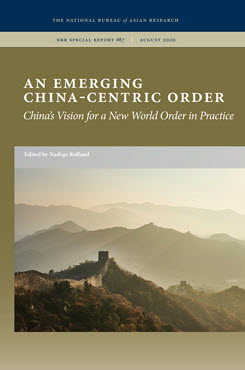NBR Special Report no. 87
An Emerging China-Centric Order: Conclusion
This is a preview of the conclusion to the NBR Special Report “An Emerging China-Centric Order: China’s Vision for a New World Order in Practice.” Download the report to read the full conclusion.
Since assuming power in October 2012, Xi Jinping has embarked on an ambitious course to achieve the “great rejuvenation of the Chinese nation.” This agenda hails the “tremendous transformation” of China into a strong country, one that not only is economically successful and politically stable but also enjoys a central position on the global stage, commensurate with its economic and military might.[1] To achieve this objective, China’s strategy rests on three main pillars, according to Men Honghua, a professor at the Central Party School: integrating with the world, transforming itself, and shaping the world.[2]
The Chinese leadership has not clearly nor openly defined the exact shape it would like to give the world, however. The National Bureau of Asian Research (NBR) launched the project “China’s Vision for a New Regional and Global Order” to investigate this question. Current analyses of China’s strategic vision for its place in the world order only provide partial answers. Some studies have focused on the visible manifestations of China’s rise and its current external actions and behavior, but this line of inquiry can take us only so far. The fact that Beijing has not yet sought major changes in the regional and international status quo does not necessarily mean that it is not interested in eventually doing so. Using theoretical frameworks to make predictions also leads to indeterminate answers. One variant of the realist theory of international relations, for example, contends that a rising power will contest the existing order and seek to substitute its own dominance for that of the existing hegemon, most likely resulting in conflict. But how a rising power behaves will depend on how its leaders perceive threats, define their interests, and envision the world they are trying to create.
So, how do China’s leaders think about these issues? The answers are not obvious or easy to discern. Paying attention to the official Chinese Communist Party (CCP) pronouncements can provide some clues, even though party leaders often deliberately obfuscate or stay ambiguous about their true ultimate goals. Additional insights can be gleaned from a careful study of the discussions occurring within the analytical community surrounding the political elites. Based on a close reading of these statements and writings, the project’s first report reached the following conclusions.[3] What the current CCP leadership seems to have in mind, at least in the medium term, is a new, partial system carved out of the existing international order. This system would be hierarchical, with China at the top as well as at the center; it would not be global, but neither would it be merely regional. Indeed, it could eventually expand to include much of the developing, non-Western world. Within the confines of this subsystem, China would not seek total, tight control over or full absorption of other countries, but it would rigorously oppose liberal democratic principles, in all their applications and forms. In sum, Beijing seems to favor the emergence of a “partial, loose, and malleable” form of hegemony, whose defining features would reflect both the character of China’s contemporary political system and ancient Chinese thought and statecraft.
The second phase of the project seeks to observe China’s behavior in a variety of geographic and functional domains in order to discern the extent to which pieces of a new Sinocentric subsystem may already be emerging. The essays presented in this report suggest that, while this system is still very much a work in progress and has not yet taken a definitive shape, some features are already clearly discernible. Although these visible elements can be interpreted in various ways, there are some striking similarities between the ancient tribute system and the way Beijing currently engages with parts of the outside world. These similarities are more than coincidental, as will be shown, but neither do they indicate a rigid mold that shapes every aspect of China’s diplomatic praxis. The tribute system was a product of Confucianism: it applied Confucian norms of hierarchy and ritual and ultimately was incarnated in what could be called a “Confucian international order.”[4] Today’s China is a Marxist-Leninist state guided not by Confucianism but by the Xi Jinping Thought on Socialism with Chinese Characteristics for a New Era. The filaments of tianxia (everything under heaven) are thus interwoven with the strands of a modern Marxist-Leninist power structure, organization, and ideological system, sometimes to the point that they are indistinguishable from one another. Both have power and domination in common, but the intertwining of their respective strands in a Chinese cultural context creates a pattern that is distinct and unique to China.
Endnotes
[1] “Full Text of Xi Jinping’s Report at 19th CPC National Congress,” Xinhua, November 3, 2017, http://www.xinhuanet.com/english/special/ 2017-11/03/c_136725942.htm.
[2] Men Honghua, “Dang Zhongyang zhiguo lizheng xin linian xin sixiang xin zhanlüe: Yixiang guoji yanjiu yicheng” [New Concepts, Ideas, and Strategies for the CCP Central Committee’s National Governance: An International Research Agenda], Institute of World Economics and Politics, Chinese Academy of Social Sciences, 2017, http://www.iwep.org.cn/cbw/cbw_wzxd/201711/t20171109_3736929.shtml.
[3] Nadège Rolland, “China’s Vision for a New World Order,” National Bureau of Asian Research, NBR Special Report, no. 83, January 2020, https://www.nbr.org/wp-content/uploads/pdfs/publications/sr83_chinasvision_jan2020.pdf.
[4] Timothy Brook, Michael van Walt van Praag, and Miek Boltjes, “Interpolity Relations and the Tribute System of Ming China,” in Sacred Mandates: Asian International Relations Since Chinggis Khan, ed. Timothy Brook, Michael van Walt van Praag, and Miek Boltjes (Chicago: University of Chicago Press, 2018), 57–89, 64.
Nadège Rolland is Senior Fellow for Political and Security Affairs at the National Bureau of Asian Research (NBR). She is the author of the report “China’s Vision for a New World Order” (2020) and the monograph China’s Eurasian Century? Political and Strategic Implications of the Belt and Road Initiative (2017).



